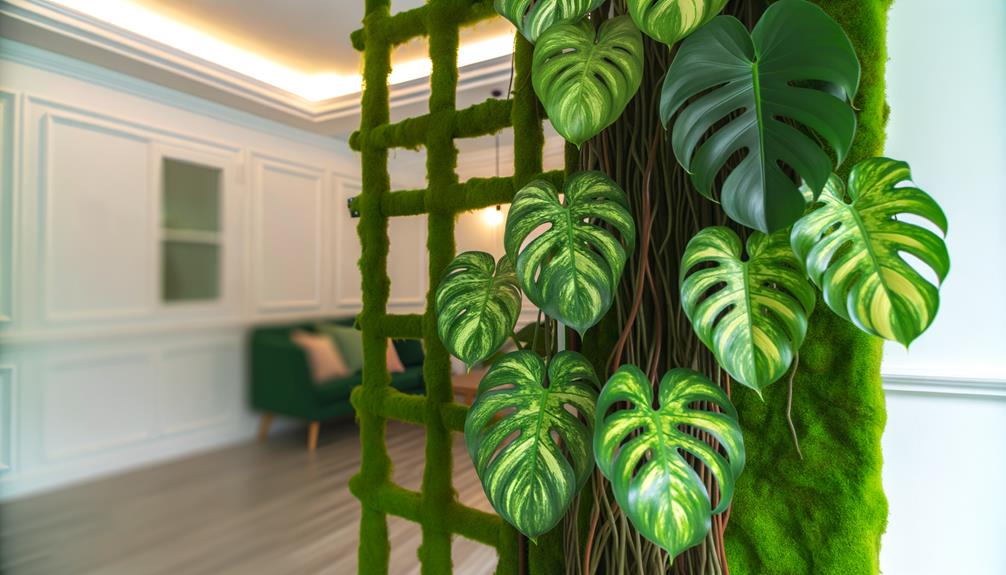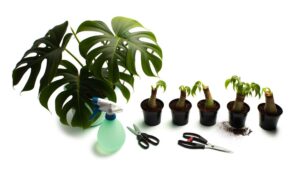Monstera Standleyana Climbing Support
Supporting your Monstera Standleyana promotes ideal vertical growth and health. Choose durable materials like moss poles, trellises, or bamboo stakes.
These tools improve structural integrity and light-seeking response, aiding in effective photosynthesis and nutrient transportation. A moss pole provides necessary assistance for aerial roots, while a trellis adds visual appeal and strength.
Place your climbing support near the plant's base and secure stems with gentle ties. Regular upkeep, like trimming and pest examination, is essential for continual growth.
These actions will imitate the plant's original environment, encouraging efficient physiological processes and abundant foliage. Keep exploring for deeper insights.

Key Takeaways
- Choose sturdy supports like moss poles, trellises, or bamboo stakes to facilitate vertical growth and aerial root development.
- Ensure supports are inserted 2-3 inches into the soil and securely fastened to handle the plant's mature weight.
- Regularly adjust ties and prune to guide the plant's growth and optimize its climbing potential.
- Maintain a consistent watering schedule and monitor soil moisture to prevent root rot and support healthy growth.
- Regularly inspect for pests and use appropriate control methods to keep the plant healthy and thriving.
Choosing the Right Support
Choosing the right support for your Monstera Standleyana involves assessing its natural climbing tendencies and growth requirements. This species displays epiphytic behavior, thriving by climbing on other structures in its native environment.
You'll need to contemplate support materials such as moss poles, trellises, or coir poles, which replicate the texture of natural substrates. Evaluate the diameter and height of these supports to guarantee they align with the aerial root capabilities and overall growth potential of your Monstera.
Also, take into account the plant's phototropic response, as it looks for light sources for optimal photosynthesis. Make sure that the support structure is robust enough to handle the weight and size of a mature Monstera Standleyana, thus encouraging healthy, sustained growth.
Benefits of Climbing Support
Providing climbing support for your Monstera Standleyana enhances its structural integrity, allowing the plant to exhibit its natural growth patterns and optimize nutrient absorption.
When you provide a climbing framework, the plant benefits in several ways:
- Enhanced Photosynthesis: Elevated leaves receive more light, boosting photosynthetic efficiency.
- Improved Air Circulation: Climbing reduces leaf congestion, minimizing fungal and bacterial infections.
- Optimized Nutrient Distribution: Vertical growth facilitates effective nutrient transport, promoting robust development.
This support mechanism mimics the plant's native habitat, ensuring physiological and biochemical processes operate efficiently. By understanding these benefits, you can better care for your Monstera Standleyana, ensuring it thrives in a controlled environment. Employ precise techniques to maximize the plant's potential and longevity.
Moss Poles for Monstera
When you use moss poles for your Monstera Standleyana, you'll provide essential structural support, promoting vertical growth and healthier foliage.
Installing a moss pole requires securely anchoring it in the pot and periodically misting to maintain peak humidity.
Regular maintenance includes checking for stability and adjusting ties to accommodate growth, ensuring your plant thrives.
Benefits of Moss Poles
Why do moss poles offer significant benefits for Monstera Standleyana growth and development?
Moss poles provide essential structural support, promoting vertical growth and enabling your plant to mimic its natural climbing behavior. This support leads to healthier and more vigorous development.
Consider these advantages:
- Enhanced Stability: Moss poles anchor the plant, reducing the risk of toppling and ensuring robust root attachment.
- Improved Aerial Root Development: The moisture-retentive surface of moss poles encourages the formation of aerial roots, which are vital for nutrient absorption.
- Optimal Leaf Size and Shape: When climbing, Monstera Standleyana tends to produce larger, more fenestrated leaves, enhancing its aesthetic appeal and photosynthetic efficiency.
Installation and Maintenance
To safeguard your Monstera Standleyana thrives, start by firmly inserting the moss pole into the potting mix near the plant's base, guaranteeing it reaches the bottom of the container for best stability.
Secure the plant to the pole using soft plant ties, ensuring the ties are snug but not constricting.
Regularly mist the moss pole to maintain high humidity levels, promoting root adhesion and aerial root growth.
Monitor the plant's growth and adjust ties as necessary to support new shoots.
Inspect the moss pole periodically for signs of wear or mold, replacing it if deterioration occurs.
Trellis Options
Selecting the right trellis for your Monstera Standleyana is crucial for promoting the best growth and stability. You need to take into account structural integrity, material durability, and ease of installation.
Here are three trellis options that you might find effective:
- Metal Trellises: These provide excellent support and longevity due to their sturdy construction. They're ideal for heavy climbing plants.
- Wooden Trellises: While visually appealing, these may require regular upkeep to prevent decay, especially in high-humidity environments.
- Plastic Trellises: Lightweight and resistant to moisture, plastic trellises are simple to install and maintain. However, they may lack the strength required for larger plants.
Evaluate these options based on your specific environmental conditions and plant growth habits to ensure the best support.
Using Bamboo Stakes
Although bamboo stakes might seem simplistic, they provide excellent support for Monstera Standleyana due to their natural strength and flexibility. Bamboo's tensile strength allows it to bear the plant's weight without deforming.
Insert bamboo stakes vertically into the soil, ensuring they're deep enough to be stable. Tie the Monstera's stems to the stakes using plant ties or soft twine, maintaining a gentle tension to avoid damaging the plant tissue.
Position the stakes strategically to guide the plant's growth upward, facilitating better light exposure and air circulation. Bamboo's organic composition also integrates aesthetically with the plant, enhancing visual harmony.
Regularly monitor the ties and adjust as the Monstera matures to maintain the best possible support and prevent constriction.
DIY Climbing Structures
To create effective DIY climbing structures for your Monstera Standleyana, start by gathering essential materials such as wooden dowels, trellis netting, or metal rods.
Follow straightforward assembly steps to build a stable support system that promotes vertical growth.
Proper placement and regular maintenance will promote plant health and structural stability.
Materials and Tools Needed
Gathering the right materials and tools is crucial for constructing effective DIY climbing structures for your Monstera Standleyana. Precise selection guarantees structural integrity and plant health. You'll need:
- Support Poles: Choose sturdy materials like bamboo or PVC. They should be at least 1-2 meters in height to accommodate growth.
- Twine or Plant Ties: Opt for biodegradable options to secure the plant without causing damage.
- Potting Mix and Container: A well-draining mix and a spacious container allow root expansion and stability.
Verify all materials are free from contaminants to prevent disease.
Using these items will provide the necessary support and promote vertical growth, enhancing the plant's natural climbing ability and overall aesthetic.
Simple Assembly Steps
Start by positioning the support poles firmly into the container, ensuring they extend vertically and are evenly spaced for best plant support. Use a measuring tape to verify equal spacing, maintaining structural integrity.
Secure each pole at the base with a soil anchor, preventing movement.
Next, attach horizontal bars or mesh netting between the poles for additional climbing surfaces. Fasten these securely with zip ties, ensuring tautness to avoid sagging.
Finally, gently guide the Monstera Standleyana's tendrils towards the support structure, using plant ties as necessary to encourage upward growth.
Placement and Care
Once you've assembled your climbing support structure, strategically placing it in an area with ideal light conditions and sufficient space is important for the Monstera Standleyana's growth. Make sure the environment meets these key requirements:
- Light: Position the structure where the plant receives indirect, bright light. Avoid direct sunlight, which can scorch the leaves.
- Humidity: Maintain a humidity level of 60-80%. Use a humidifier or place a tray of water nearby to achieve this.
- Space: Allocate enough room for the Monstera to expand. The structure should allow vertical growth without crowding.
Regularly inspect for pests and prune as necessary to encourage healthy development. Consistent care and proper placement will optimize your Monstera Standleyana's climbing potential.
Installation Tips
To maximize growth, position the climbing support near the base of your Monstera Standleyana, anchoring it securely in the soil. Confirm the support structure is stable to prevent tipping. Attach the stems gently using plant ties, making sure they are not too tight to avoid constricting growth.
| Step | Description |
|---|---|
| 1 | Select a sturdy support, like a moss pole or trellis. |
| 2 | Insert the support 2-3 inches into the soil. |
| 3 | Secure the plant's stem using soft ties. |
| 4 | Adjust ties as the plant grows. |
Maintenance and Care
To guarantee your Monstera Standleyana remains healthy, you'll need to focus on regular pruning and trimming to control its growth and shape.
Establish a consistent watering schedule based on soil moisture levels to prevent overwatering or underwatering.
Implement effective pest control methods to mitigate common issues like spider mites and aphids.
Pruning and Trimming
Pruning and trimming your Monstera Standleyana involves removing dead or overgrown leaves and stems to promote ideal growth and overall plant health. To achieve this, you'll need to follow a precise approach:
- Identify Target Areas: Examine your plant for yellowing leaves or stems that are excessively elongated.
- Sanitize Tools: Use sterilized pruning shears to avoid introducing pathogens.
- Execute Clean Cuts: Make cuts at a 45-degree angle near the node, ensuring minimal damage.
Watering Schedule
Maintaining proper hydration for your Monstera Standleyana involves keeping a consistent watering schedule that keeps the soil moist but not waterlogged. You should water when the top inch of soil feels dry to the touch, typically every 7-10 days.
Utilize a well-draining soil mix to prevent root rot, and make sure the pot has adequate drainage holes. During the growing season (spring and summer), increase watering frequency slightly. Conversely, reduce watering in the dormant periods of fall and winter.
Monitor environmental factors like humidity and temperature, as they affect soil moisture levels. Avoid using chlorinated water; distilled or rainwater is preferable to minimize chemical exposure. Regularly check for signs of overwatering, such as yellowing leaves or root rot.
Pest Control Methods
When dealing with pest control for your Monstera Standleyana, regularly inspect the plant for signs of common pests like spider mites, aphids, and mealybugs to maintain its health and vigor. Early detection is essential to prevent infestations.
Here are three key methods:
- Mechanical Removal: Gently wipe leaves with a damp cloth to physically eliminate pests.
- Chemical Control: Apply insecticidal soap or neem oil, following manufacturer's instructions, to target and eradicate pests.
- Biological Control: Introduce beneficial insects like ladybugs or predatory mites to naturally decrease pest populations.
Consistent monitoring and prompt intervention are important. By understanding these methods and their applications, you can effectively manage pest issues and guarantee your Monstera Standleyana thrives.
Common Mistakes
Neglecting to provide sufficient structural assistance for your Monstera Standleyana can impede its growth and lead to a less visually pleasing appearance.
One common mistake is using inadequately strong materials. Feeble supports can collapse under the plant's weight, causing physical harm.
Another error is positioning the support incorrectly. If the support isn't close enough to the plant's base, the Monstera won't effectively climb, leading to elongated, feeble stems.
Additionally, failing to secure the plant regularly can result in uneven growth and potential stem breakage.
Overlooking the plant's natural growth patterns is another common issue; you should guide it gently to follow its vertical inclination.
Properly addressing these mistakes ensures prime health and vitality for your Monstera Standleyana.
Enhancing Aesthetics
Properly supporting your Monstera Standleyana not only prevents common growth issues but also enhances the plant's aesthetics, making it a stunning focal point in your space.
To achieve ideal visual appeal, consider the following:
- Support Structures: Utilize moss poles or trellises to guide vertical growth, ensuring even light distribution and structural integrity.
- Pruning Techniques: Regularly prune to maintain desired shape and remove any damaged or discolored leaves, promoting vigorous growth.
- Placement: Position your plant in a location with indirect light, as this enhances leaf variegation and overall health.
These strategies will help you create a visually appealing environment while ensuring your Monstera Standleyana thrives.
Conclusion
Coincidentally, as you explore providing the perfect climbing support for your Monstera standleyana, you'll notice an enhanced growth pattern. Employing moss poles or trellises doesn't just facilitate vertical expansion—it improves overall plant health.
By meticulously installing and maintaining these supports, you mitigate common issues like stem breakage or poor aeration. Ultimately, this precise approach to plant care isn't just beneficial; it's essential for a thriving, aesthetically pleasing Monstera standleyana.






